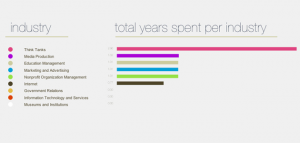What’s the last great movie you saw or book you read? The answer likely pops right into your mind. What’s the last great piece of marketing content that you remember? That answer might not come as quickly.
Good story lines undoubtedly connect and stick with audiences, whereas a company’s tagline may not.
“I think as marketing and advertising evolves and gets more digital, people are getting completely overwhelmed with the noise of it all. The story line and narrative is something that in the world that we live in people can resonate with. It’s intrinsic in our human nature for story lines to resonate. So it’s just of way of engaging with people as individuals in a way that they can relate to,” said Michelle Killebrew, Social Business Strategy Program Director at IBM.
“If you focus on the storytelling; if you focus on what your products and services do, it means that you’re reaching people in a much more interesting way because basically nobody cares about products and services. What they care about are themselves and what they care about is solving problems,” said David Meerman Scott, Marketing and Sales Strategist and author of “The New Rules of Marketing & PR” and “Newsjacking”.
Customized, Relevant Messaging
Weaving a narrative around your company involves thoroughly understanding what the company is about and the message for which it stands. David Meerman Scott, Marketing and Sales Strategist and author of “The New Rules of Marketing & PR” and “Newsjacking”, said understanding what it is your company does is what’s important with storytelling.
“I think businesses need to use [storytelling] all the time — when talking about their values, their mission statement, and when talking to their customers or prospects about their solutions and offerings. It seems to have evolved as the new norm for how we communicate with one another,” said Michelle Killebrew, Social Business Strategy Program Director at IBM.”
“If you focus on the storytelling; if you focus on what your products and services do, it means that you’re reaching people in a much more interesting way because basically nobody cares about products and services. What they care about are themselves and what they care about is solving problems,” he said. “So if you focus on storytelling, if you focus on creating information that’s interesting for people, then you’re not just doing a product pitch. You’re not just talking about yourself. You’re not egocentric. Instead, you’re creating information of interest to people.”
Making content interesting means you’re striking a chord with the audience. To accomplish that, you need to know them inside and out. Scott said you have to start from the perspective of the buyer you’re trying to reach.
“How much can you learn about them? How much can you understand about who they are? Then can you create something that’s specifically designed for them and specifically addresses their needs and specifically addresses their problems. And like I say, that kind of focuses away from what most companies do which is talk about their products and services,” he said.
What Makes for Good Storytelling?
Kevin Spacey discusses importance of storytelling – Content Marketing World 2014
by Content Marketing Ins… via YouTube
The story needs to be meaningful or provocative in order to resonate with the audience. What makes a good story? For starters, a beginning, middle and end. Beyond that, the story line takes planning. Killebrew said that even in an annual report there’s a story line — a beginning, middle and end, but the approach is all in the communication.
“How can you make somebody other than yourself a hero in your story?” Meerman asked.
“I think businesses need to use [storytelling] all the time — when talking about their values, their mission statement, and when talking to their customers or prospects about their solutions and offerings. It seems to have evolved as the new norm for how we communicate with one another,” she said.
Fictional books and films have conflict, which make for a compelling plot. Meerman said he’s fan of understanding how to use conflict in storytelling, which is almost never used in business writing.
https://youtu.be/I35a-ha1c9E
A Day In The Life Of Lysa Banks, Lead Architect for Industry Cloud Solutions
by IBM via YouTube
“Which is one reason why most business writing stinks,” he said. “So what does that mean when it comes to business writing? It means that you need to think about who are the bad guys in your story and how you can paint those bad guys in some particular light that brings conflict into your story. How can you make somebody other than yourself a hero in your story? Maybe that’s your customer. Maybe that’s the way that people in your market react to the regulatory agencies. I mean, something like that becomes a basis for the conflict that you can build into your writing and that becomes really, really important. … So few people actually use that technique because they’re just writing the way that they were taught to write, which is about products and services.”
Taking an Episodic Storytelling Approach
Brands are telling multi-part stories within an overall story line. Killebrew said episodic storytelling is increasingly being talked about and that we’ll see more of it in the near future.
“I think one of the things we’re seeing in a lot of different types of marketing is episodic storytelling because our attention is shorter, we have a tolerance for the marketing to be very direct and to the point and that gives us the opportunity to engage with our audience over time through a series of shorter advertising that ties into an overarching story line,” she said.
https://youtu.be/YW1yZPflIXY
#GALAXY11: The Training
by Samsung Mobile via YouTube
During the World Cup, Samsung ran a series of science-fiction themed ads with Galaxy 11 featuring Cristiano Ronaldo, Mario Gotze and Lionel Messi who fought off aliens, according to the Wall Street Journal. Samsung’s “The Training” video hit 74 million online views in July to become the third most viewed World Cup video, the WSJ reported.
Content you like, retweet, share, +1 and comment on your social networks typically evokes emotion. Storytelling is a way to hook people in to pay attention to your brand, not necessarily your product or service. Those businesses that can pull off narrative well can make a memorable impression on their target audience.
Click here to see how Rock Content can help you measure your content’s engagement and use that to achieve business goals.








